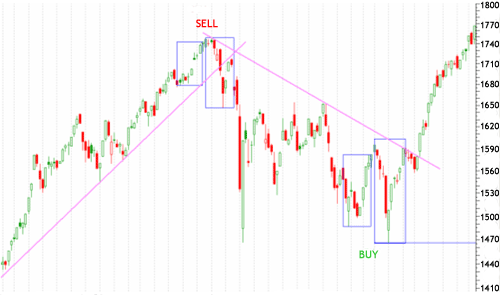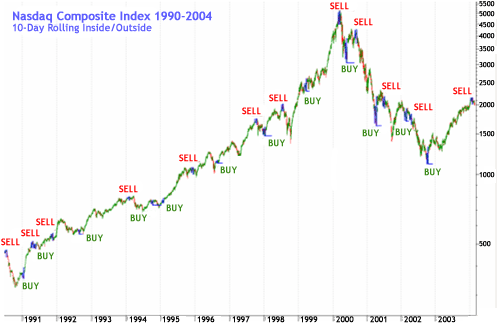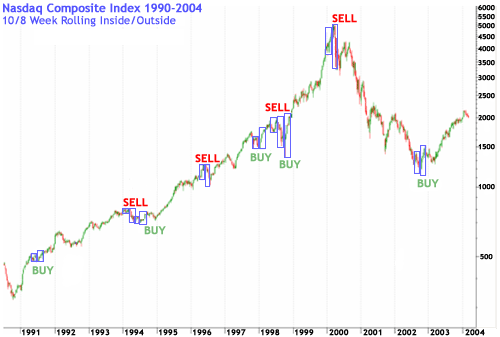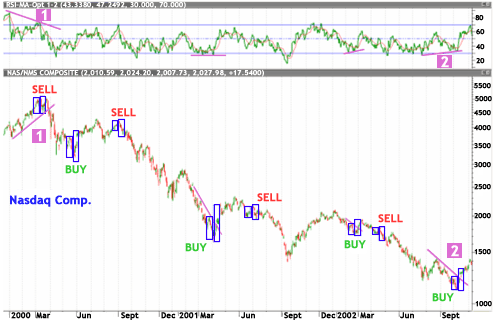Traders have an expression for attempting to pick a market top or bottom - they call it trying to catch a falling knife. As the expression implies, it can be downright dangerous and is not normally recommended. But here is a method that may help lower the risk.
Sushi Roll Anyone?
In his book, "The Logical Trader," author Mark Fisher discusses techniques for identifying potential market tops and bottoms. While they serve the same purpose as the head and shoulders or double top/bottom or triple top/bottom chart patterns discussed in Bulkowski's seminal work "Encyclopedia of Chart Patterns," Fisher's techniques give signals sooner, providing an early warning alert to possible changes in the direction of the current trend.
One technique that Fisher calls the "sushi roll" has nothing to do with food, except that it was conceived over lunch where a number of traders were discussing market set-ups. He defines it as a period of 10 bars where the first five (inside bars) are confined within a narrow range of highs and lows and the second five (outside bars) engulf the first with both a higher high and lower low. (The pattern is similar to a bearish or bullish engulfing pattern except that instead of a pattern of two single bars, it is composed of multiple bars.) In his example, Fisher uses 10-minute bars.
When the sushi roll pattern shows up in a downtrend, it warns of a possible trend reversal, showing that it's a good time to look to buy or at the very least, exit a short position. If it occurs during an uptrend, the trader gets ready to sell. While Fisher discusses five-bar patterns, the number or duration of bars is not set in stone. The trick is to identify a pattern consisting of the number of both inside and outside bars that are the best fit with the chosen stock or commodity using a time frame that matches the overall desired time in the trade.
The second trend reversal pattern that Fisher recommends is for the longer-term trader and is called the outside reversal week. Basically, it is a sushi roll except that it uses daily data starting on a Monday and ending on a Friday. It takes a total of 10 days and occurs when a five-day trading inside week is immediately followed by an outside or engulfing week with a higher high and lower low.
Testing Testing…
With this idea in mind, we examined a chart of the Nasdaq Composite Index (IXIC) to see if the pattern would have helped identify turning points during the 14 years from 1990-2004. In the doubling of the period of the outside reversal week to two 10-daily bar sequences, signals were less frequent but proved more reliable. Constructing the chart consisted of using two trading weeks back to back so that our pattern started on a Monday and took an average of four weeks to complete (see Figure 1). We called this pattern the rolling inside/outside reversal (RIOR).
In Figure 1, each 10-bar part of the pattern is outlined by a blue rectangle. Note the magenta trend lines showing the dominant trend. The pattern often acts as a good confirmation that the trend has changed and will be followed shortly after by a trend line break. As you can see, the first 10-bar rectangle fits inside the upper and lower boundaries of the second. Also note the horizontal line on the right side of the chart showing the low of the outside rectangle, which is a good place for a stop loss.

Fig 1 Source: Metastock.com
Daily Nasdaq Composite chart showing a 20-bar rolling inside/outside reversal sell signal followed by a buy signal.
To test the system, we must determine how the trader using the rolling inside/outside reversal (RIOR) to enter and exit long positions would have done compared to an investor using a buy-and-hold strategy. Even though the Nasdaq composite topped out at 5132 in March 2000, due to the nearly 80% correction that followed, buying on Jan. 2, 1990 and holding until the end of our test period on Jan. 30, 2004, would still have earned the buy-and-hold (BaH) investor 1585 points over 3,567 trading days (14.1 years). At a slow and steady rate of an average 0.44 points per day, the investor would have earned an average annual return of 10.66%.
The trader who entered a long position on the open of the day following a RIOR buy signal (day 21 of the pattern) and who sold at the open on the day following a sell signal, would have entered his or her first trade on Jan. 29, 1991, and exited the last trade on Jan. 30, 2004 (with the termination of our test). This trader would have made a total of 11 trades and been in the market for 1,977 trading days (7.9 years) or 55.4% of the time. The trader, however, would have done substantially better, capturing a total of 3,531.94 points or 225% of the BaH strategy. When time in the market is considered, the RIOR trader's annual return would have been 29.31%, not including the cost of commissions. That's quite a significant difference.
It is interesting to note that, had the buy-and-hold investor used a simple stop loss or trend line break to exit after the market had retraced 10% from its Mar 2000 high of 5132, he or she would have been in the market 10.25 years and enjoyed an annual return of 22.73%, or more than double the 14-year test results. Timing really is everything, and this exercise demonstrates the power behind combining fundamentals with technicals. As we can see, ignoring market direction can be very costly.

Fig 2 Source: Metastock.com
Daily chart of Nasdaq Composite Index showing 20-day reversal patterns.
Using Weekly Data
The same test was conducted on the Nasdaq Composite Index using weekly data. This time, the first or inside rectangle was set to 10 weeks and the second or outside rectangle to eight weeks, as this combination was found to be better at generating sell signals (see Figure 3).
In total, five signals were generated and the profit was 2,923.77 points. The trader would have been in the market for 381 (7.3 years) of the total 713.4 weeks (14.1 years) or 53% of the time. This works out to an annual return of 21.46%. The weekly RIOR system is a good primary trading system but is perhaps most valuable in providing back up or fail-safe signals to the daily system.

Fig 3 Source: Metastock.com
Weekly chart of the Nasdaq Composite Index showing fewer reversal signals but they would have acted as confirmation to the daily charts. The buy signals consisted to two 10-bar patterns, the sells of a 10 and 8-bar pattern, the latter of which was found to be better at picking sell points.
Confirmation
Regardless of whether we used 10-minute or weekly bars, the trend reversal trading system worked well in our tests. But, it is important to remember that any indicator used independently can get the trader into trouble. One pillar of technical analysis is the importance of confirmation. A trading technique is far more reliable when there is a back up in the way of a secondary indicator. Given the risk in trying to pick a top or bottom of the market, it is essential that at a minimum, the trader use a trend line break to confirm a signal and always employ a stop loss in case he or she is wrong. In our tests, the relative strength index (RSI) gave good confirmation at many of the reversal points in the way of negative divergence (see Figure 4).
As an aside, it is interesting to note that the RIOR daily gave a sell signal on the Nasdaq, which would have gotten the trader out of the market at the open on Feb. 10, 2004, had the test not been terminated on January 30th.

Fig 4 Source: Metastock.com
Daily Nasdaq Composite Index showing divergence between Relative Strength Index (RSI) and price to confirm potential trend reversals. The RSI showed strong negative divergence at the 2000 top (number 1) and strong positive divergence at the 2002 bottom (number 2)
In Summary
Timing trades to enter at market bottoms and exit at tops will always involve risk, no matter which way you slice it. But techniques like the sushi roll, outside reversal week and rolling inside/outside reversal, when used in conjunction with a confirmation indicator, can be very useful trading strategies to help the trader maximize and protect his or her hard-won earnings.
Matt Blackman can be contacted at Trading Education
Sushi Roll Anyone?
In his book, "The Logical Trader," author Mark Fisher discusses techniques for identifying potential market tops and bottoms. While they serve the same purpose as the head and shoulders or double top/bottom or triple top/bottom chart patterns discussed in Bulkowski's seminal work "Encyclopedia of Chart Patterns," Fisher's techniques give signals sooner, providing an early warning alert to possible changes in the direction of the current trend.
One technique that Fisher calls the "sushi roll" has nothing to do with food, except that it was conceived over lunch where a number of traders were discussing market set-ups. He defines it as a period of 10 bars where the first five (inside bars) are confined within a narrow range of highs and lows and the second five (outside bars) engulf the first with both a higher high and lower low. (The pattern is similar to a bearish or bullish engulfing pattern except that instead of a pattern of two single bars, it is composed of multiple bars.) In his example, Fisher uses 10-minute bars.
When the sushi roll pattern shows up in a downtrend, it warns of a possible trend reversal, showing that it's a good time to look to buy or at the very least, exit a short position. If it occurs during an uptrend, the trader gets ready to sell. While Fisher discusses five-bar patterns, the number or duration of bars is not set in stone. The trick is to identify a pattern consisting of the number of both inside and outside bars that are the best fit with the chosen stock or commodity using a time frame that matches the overall desired time in the trade.
The second trend reversal pattern that Fisher recommends is for the longer-term trader and is called the outside reversal week. Basically, it is a sushi roll except that it uses daily data starting on a Monday and ending on a Friday. It takes a total of 10 days and occurs when a five-day trading inside week is immediately followed by an outside or engulfing week with a higher high and lower low.
Testing Testing…
With this idea in mind, we examined a chart of the Nasdaq Composite Index (IXIC) to see if the pattern would have helped identify turning points during the 14 years from 1990-2004. In the doubling of the period of the outside reversal week to two 10-daily bar sequences, signals were less frequent but proved more reliable. Constructing the chart consisted of using two trading weeks back to back so that our pattern started on a Monday and took an average of four weeks to complete (see Figure 1). We called this pattern the rolling inside/outside reversal (RIOR).
In Figure 1, each 10-bar part of the pattern is outlined by a blue rectangle. Note the magenta trend lines showing the dominant trend. The pattern often acts as a good confirmation that the trend has changed and will be followed shortly after by a trend line break. As you can see, the first 10-bar rectangle fits inside the upper and lower boundaries of the second. Also note the horizontal line on the right side of the chart showing the low of the outside rectangle, which is a good place for a stop loss.

Fig 1 Source: Metastock.com
Daily Nasdaq Composite chart showing a 20-bar rolling inside/outside reversal sell signal followed by a buy signal.
To test the system, we must determine how the trader using the rolling inside/outside reversal (RIOR) to enter and exit long positions would have done compared to an investor using a buy-and-hold strategy. Even though the Nasdaq composite topped out at 5132 in March 2000, due to the nearly 80% correction that followed, buying on Jan. 2, 1990 and holding until the end of our test period on Jan. 30, 2004, would still have earned the buy-and-hold (BaH) investor 1585 points over 3,567 trading days (14.1 years). At a slow and steady rate of an average 0.44 points per day, the investor would have earned an average annual return of 10.66%.
The trader who entered a long position on the open of the day following a RIOR buy signal (day 21 of the pattern) and who sold at the open on the day following a sell signal, would have entered his or her first trade on Jan. 29, 1991, and exited the last trade on Jan. 30, 2004 (with the termination of our test). This trader would have made a total of 11 trades and been in the market for 1,977 trading days (7.9 years) or 55.4% of the time. The trader, however, would have done substantially better, capturing a total of 3,531.94 points or 225% of the BaH strategy. When time in the market is considered, the RIOR trader's annual return would have been 29.31%, not including the cost of commissions. That's quite a significant difference.
It is interesting to note that, had the buy-and-hold investor used a simple stop loss or trend line break to exit after the market had retraced 10% from its Mar 2000 high of 5132, he or she would have been in the market 10.25 years and enjoyed an annual return of 22.73%, or more than double the 14-year test results. Timing really is everything, and this exercise demonstrates the power behind combining fundamentals with technicals. As we can see, ignoring market direction can be very costly.

Fig 2 Source: Metastock.com
Daily chart of Nasdaq Composite Index showing 20-day reversal patterns.
Using Weekly Data
The same test was conducted on the Nasdaq Composite Index using weekly data. This time, the first or inside rectangle was set to 10 weeks and the second or outside rectangle to eight weeks, as this combination was found to be better at generating sell signals (see Figure 3).
In total, five signals were generated and the profit was 2,923.77 points. The trader would have been in the market for 381 (7.3 years) of the total 713.4 weeks (14.1 years) or 53% of the time. This works out to an annual return of 21.46%. The weekly RIOR system is a good primary trading system but is perhaps most valuable in providing back up or fail-safe signals to the daily system.

Fig 3 Source: Metastock.com
Weekly chart of the Nasdaq Composite Index showing fewer reversal signals but they would have acted as confirmation to the daily charts. The buy signals consisted to two 10-bar patterns, the sells of a 10 and 8-bar pattern, the latter of which was found to be better at picking sell points.
Confirmation
Regardless of whether we used 10-minute or weekly bars, the trend reversal trading system worked well in our tests. But, it is important to remember that any indicator used independently can get the trader into trouble. One pillar of technical analysis is the importance of confirmation. A trading technique is far more reliable when there is a back up in the way of a secondary indicator. Given the risk in trying to pick a top or bottom of the market, it is essential that at a minimum, the trader use a trend line break to confirm a signal and always employ a stop loss in case he or she is wrong. In our tests, the relative strength index (RSI) gave good confirmation at many of the reversal points in the way of negative divergence (see Figure 4).
As an aside, it is interesting to note that the RIOR daily gave a sell signal on the Nasdaq, which would have gotten the trader out of the market at the open on Feb. 10, 2004, had the test not been terminated on January 30th.

Fig 4 Source: Metastock.com
Daily Nasdaq Composite Index showing divergence between Relative Strength Index (RSI) and price to confirm potential trend reversals. The RSI showed strong negative divergence at the 2000 top (number 1) and strong positive divergence at the 2002 bottom (number 2)
In Summary
Timing trades to enter at market bottoms and exit at tops will always involve risk, no matter which way you slice it. But techniques like the sushi roll, outside reversal week and rolling inside/outside reversal, when used in conjunction with a confirmation indicator, can be very useful trading strategies to help the trader maximize and protect his or her hard-won earnings.
Matt Blackman can be contacted at Trading Education
Last edited by a moderator:
